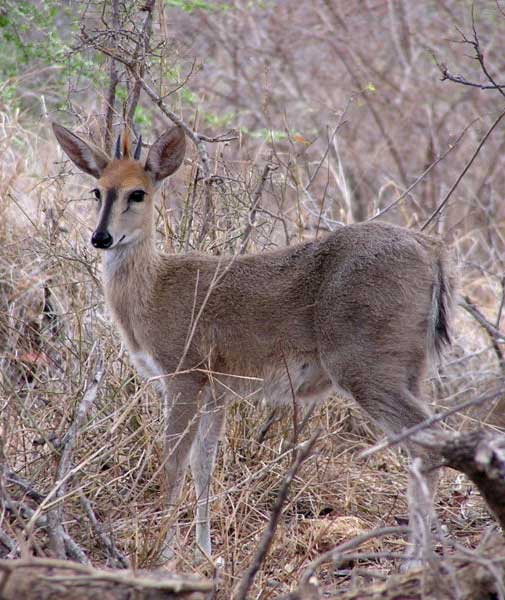
Sylvicapra grimmia (*)
Superregnum: Eukaryota
Regnum: Animalia
Subregnum: Eumetazoa
Cladus: Bilateria
Cladus: Nephrozoa
Superphylum: Deuterostomia
Phylum: Chordata
Cladus: Craniata
Subphylum: Vertebrata
Infraphylum: Gnathostomata
Superclassis: Tetrapoda
Cladus: Reptiliomorpha
Cladus: Amniota
Cladus: Synapsida
Cladus: Eupelycosauria
Cladus: Sphenacodontia
Cladus: Sphenacodontoidea
OrdoTherapsida
Cladus: Theriodontia
Subordo: Cynodontia
Cladus: Mammaliaformes
Classis: Mammalia
Subclassis: Trechnotheria
Infraclassis: Zatheria
Supercohort: Theria
Cohort: Eutheria
Cohort: Placentalia
Cladus: Boreoeutheria
Superordo: Laurasiatheria
Ordo: Artiodactyla
Subordo: Ruminantia
Familia: Bovidae
Subfamilia: Cephalophinae
Genus: Sylvicapra
Species: Sylvicapra grimmia
Subspecies: S. g. altivallis – S. g. caffra – S. g. campbelliae – S. g. coronata – S. g. grimmia – S. g. hindei – S. g. lobelarium – S. g. madoqua – S. g. nyansae – S. g. orbicularis – S. g. pallidior – S. g. splendidula – S. g. steinhardti
Name
Sylvicapra grimmia (Linnaeus, 1758)
Original combination: Capra grimmia
Type locality: "Habitat in Africa"; based on a specimen seen by Grimm in the fort at Cape Town (Thomas, 1911a:153) so now known to be South Africa, Western Cape Prov., Cape Town
References
Linnaeus, C. 1758. Systema Naturae per regna tria naturæ, secundum classes, ordines, genera, species, cum characteribus, differentiis, synonymis, locis, Tomus I. Editio decima, reformata. Holmiæ: impensis direct. Laurentii Salvii. i–ii, 1–824 pp DOI: 10.5962/bhl.title.542: 70. Reference page.
Sylvicapra grimmia in Mammal Species of the World.
Wilson, Don E. & Reeder, DeeAnn M. (Editors) 2005. Mammal Species of the World – A Taxonomic and Geographic Reference. Third edition. ISBN 0-8018-8221-4.
IUCN: Sylvicapra grimmia (Linnaeus, 1758) (Least Concern)
Vernacular names
Afrikaans: Gewone duiker
አማርኛ: ሚዳቋ
azərbaycanca: Kolluq dukeri
català: Duiquer comú
čeština: Chocholatka schovávaná
Deutsch: Kronenducker
English: Common Duiker, Grey Duiker
español: Duiker común o duiker gris
suomi: Grimminsukeltajakauris
français: Céphalophe de Grimm
Hausa: Gada
magyar: Pusztai bóbitásantilop
italiano: Silvicapra
Nederlands: Gewone duiker
polski: Grym
پنجابی: ڈوئکر
português: Sylvicapra grimmia
русский: Кустарниковый дукер
svenska: Grådykare
粵語: 灰遁羚
The common duiker (Sylvicapra grimmia), also known as the grey or bush duiker, is a small antelope found everywhere in Africa south of the Sahara, excluding the Horn of Africa and the rainforests of the central and western parts of the continent. Generally, they are found in habitats with sufficient vegetation cover to allow them to hide—savanna and hilly areas, including the fringes of human settlements.
Description
The female of common duiker at the Kruger National Park. Unlike the male, the female is hornless.
Colouration of this species varies widely over its vast geographic range. There are 14 subspecies described,[1] ranging from chestnut in forested areas of Angola to grizzled gray in northern savannas and light brown shades in arid regions. It grows to about 50 cm (20 in) in height and generally weighs 12 to 25 kg (26 to 55 lb); although females are generally larger and heavier than the males. Only the male has horns and these can grow to 11 cm (4.3 in) long.
Behavior
Breeding is year round and the female gives birth to one fawn after a gestation period of 6 to 7.5 months. The common duiker has a wide diet; beyond herbivorous browsing for leaves, flowers, fruits and tubers, they will also eat insects, frogs, small birds and mammals, and even carrion. As long as they have vegetation to eat (from which they get some water), they can go without drinking for very long periods. In the rainy season, they will frequently not drink water at all, instead obtaining fluids from fruits. They will often scavenge for these fruits below trees in which monkeys are feeding. They are active both day and night, but become more nocturnal near human settlements.
Males are territorial and smear gland secretions on rocks and branches to mark their territories; their preferred resting places are generally on elevated ground, where they can observe their territory. Females, by contrast, prefer deeper cover. The overall success of this species stems from its ability to inhabit a wide variety of habitats, as well as from its adaptable, generalist diet.
Gallery
In Kruger National Park
Juvenile male in Kidepo Valley National Park, Uganda
Notes
IUCN SSC Antelope Specialist Group (2016). "Sylvicapra grimmia". IUCN Red List of Threatened Species. 2016: e.T21203A50194717. doi:10.2305/IUCN.UK.2016-1.RLTS.T21203A50194717.en. Retrieved 19 November 2021.
References
Animal. Smithsonian Institution, 2005, pg. 250
Alden, P. C., et al. Collins Guide to African Wildlife. Harper Collins, 2004.
Clutton-Brock, J., ed. Dorling Kindersley Mammal Handbook. Dorling Kindersley Limited, 2002.
Briggs, P. East African Wildlife. Bradt Travel Guides Limited, 2007.
Retrieved from "http://en.wikipedia.org/"
All text is available under the terms of the GNU Free Documentation License

